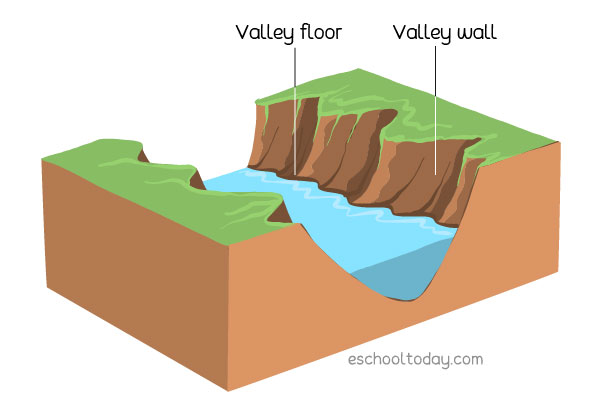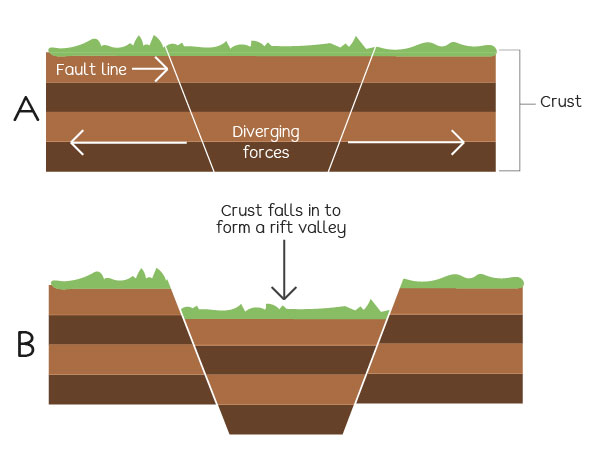- Landforms
What is a Valley?
A valley is a low-lying landmass (a depression) that is bounded by higher grounds, often mountains and hills. A valley can just be the area at the foot of two mountains, but they can also run for many miles. Valleys may or may not have water in them. They can be U-shaped or V-shaped. The sides or walls of the valley may be steep or gentle sloping. The bottom of a valley is called the Floor. It can be flat or V-shaped too. There are different types of valleys, known by their features or by the way they were formed.
River Valleys:
Below is an illustration of a river valley:
 These are valleys with water flowing through them. Any time water flows on the surface of the earth, it can erode the land and the rocks along its path. With time, it carves out channels and forms a valley. Canyons are types of valleys too. The features of river valleys depend on the speed and power of the water running through it. It also depends on the mineral make-up of the rock over which the water is flowing.
These are valleys with water flowing through them. Any time water flows on the surface of the earth, it can erode the land and the rocks along its path. With time, it carves out channels and forms a valley. Canyons are types of valleys too. The features of river valleys depend on the speed and power of the water running through it. It also depends on the mineral make-up of the rock over which the water is flowing.
Rift Valleys:

Earth movements can result in valleys too. Divergent forces acting on the earth’s crust can pull plates apart and create valleys. Rift valleys usually have steep flat sides.
Glacial Valley:
Glacial Valleys are also common in the North and south poles. They are usually U-shaped. Moving ice has tremendous power and this cuts through the slopes on which they slide. Sometimes they widen gullies along slopes and cut deeper through them. After the ice melts, dry valleys are left behind.
Our research for this topic included these sources:
Our understanding of this lesson was shaped by reading many materials including:
1. EENS 1110, Dserts, Physical Geology. By Prof. Stephen A. Nelson, Tulane University
www.tulane.edu/~sanelson/eens1110/deserts.htm
2. Volcanism and Plate Tectonics. Lynn E. Newman , December 28, 2006.
http://web.gccaz.edu/~lnewman/gph111/topic_units/igneous_vulcanism/igneous_vulcanism2.html
3. Geographic Landforms, Scotts Bluff National Monument Nebraska
www.nps.gov/scbl/planyourvisit/upload/Geographic-Landforms.pdf
4. Rivers & Deltas, © The Geological Society of London
hwww.geolsoc.org.uk/ks3/gsl/education/resources/rockcycle/page3604.html
5. Crustal Deformation & Mountain Building
www.appstate.edu/~marshallst/GLY1101/lectures/11-Deformation.pdf
6. Quick Facts on Ice Sheets, National Snow and Ice Data Center.
https://nsidc.org/cryosphere/quickfacts/icesheets.html
7.What is the difference between lava and magma? Matt Williams, 21 May , 2016 Universe today.
www.universetoday.com/27908/what-is-the-difference-between-lava-and-magma/
8. Wind Erosion www.environment.nsw.gov.au/soildegradation/winder.htm
9. The National Soil Erosion Research Laboratoryhttp://milford.nserl.purdue.edu/weppdocs/overview/wndersn.html
